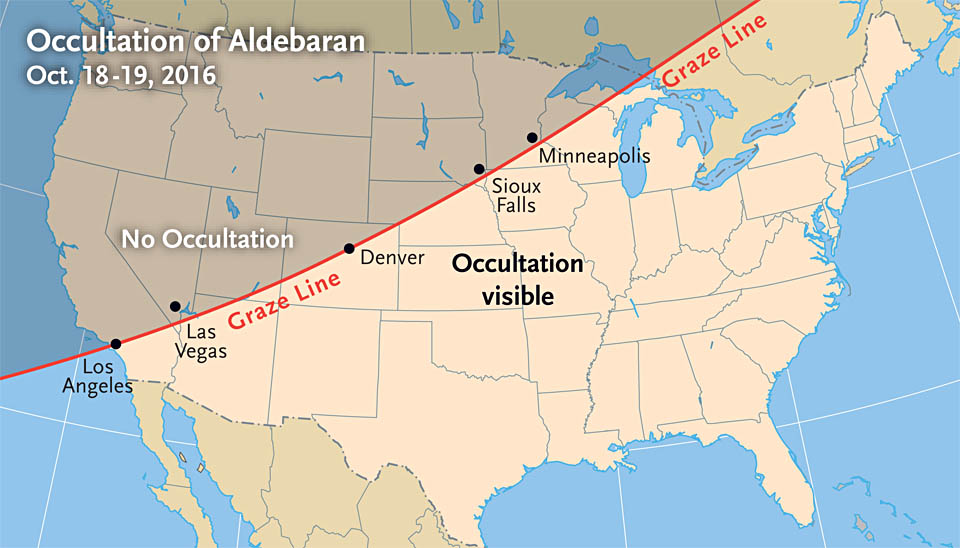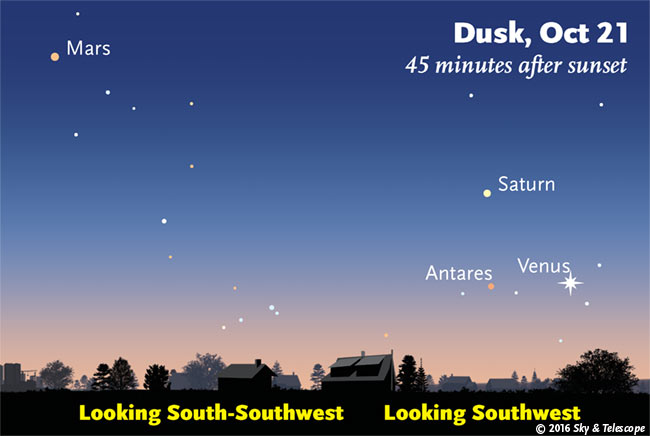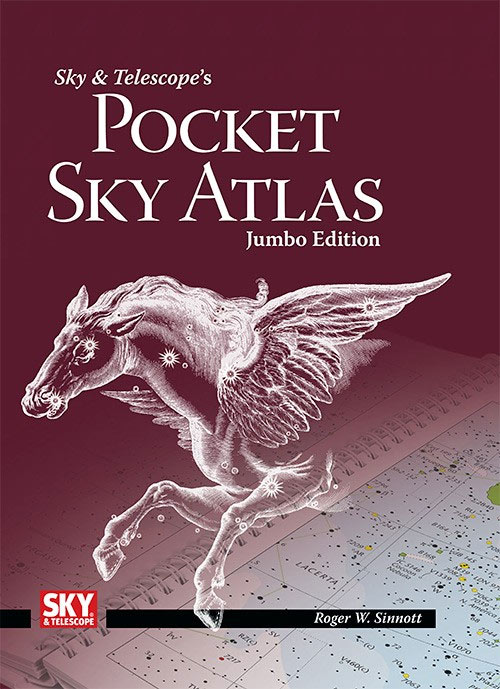Astronomy - This Week’s Sky at a Glance, October 14 – 22

Saturn and Antares advance closer to bright Venus this week. And they're moving ever farther from Mars, way off to their left.

Mars starts the week just above the Teapot's handle.
Friday, October 14
• This is the time of year when the Big Dipper lies level low in the north-northwest in mid-evening. Look two fists at arm's length above it for Kochab, the brightest star in the bowl of the Little Dipper.
Saturday, October 15
• Full Moon (exact at 12:23 a.m. EDT tonight). The Moon rises around sunset due east. After dark, look almost 20° left of the Moon for the brightest stars of Aries.
• Faint Uranus, like the Moon this evening, is at opposition. (They're less than 4° apart for the Americas).
Sunday, October 16
• This is the time of year when, just after nightfall, W-shaped Cassiopeia stands on end halfway up the northeastern sky — and when, three fists to its left, the dim Little Dipper extends leftward from Polaris in the north.
• Algol shines at minimum brightness for about two hours centered on 9:49 p.m. EDT.
Monday, October 17
• Vega is the brightest star high in the west these evenings. Less high in the southwest is Altair, not quite as bright. Just upper right of Altair, by a finger-width at arm's length, is distant orange Tarazed. Straight down from Tarazed runs the stick-figure backbone of the constellation Aquila, the Eagle.

Most people in North and Central America will be positioned for the Moon’s October 18–19 coverup of Aldebaran. It happens in a dark sky late at night.
Sky & Telescope diagram / source: IOTA
Sky & Telescope diagram / source: IOTA
Tuesday, October 18
• The waning gibbous Moon occults 1st-magnitude Aldebaran late tonight for most of the eastern, central, and southwestern US, and southeastern Canada. The star disappears on the Moon's bright limb and reappears from behind its dark limb. The graze line crosses Los Angeles and Denver. Some Hyades stars get occulted too. See our article Moon to Cover Bright Star Aldebaran, with maps, time predictions, and other information.
Wednesday, October 19
• The Great Square of Pegasus is now high in the east-southeast after dark — still, for now, balancing on one corner (seen from the world's mid-northern latitudes).
• The modest Orionid meteor shower should be active for the next several mornings, but the light of the waning gibbous Moon will interfere with the viewing.
Thursday, October 20
• After dark, spot the W of Cassiopeia standing on end high in the northeast. The third segment of the W, counting from the top, points almost straight down. Extend it twice as far down and you're at the Double Cluster in Perseus. This pair of star-swarms is dimly apparent to the unaided eye in a dark sky, and it's visible from almost anywhere in binoculars or a small, wide-field telescope at low power.
Friday, October 21
• Saturn and Antares now form a more compact, right triangle with bright Venus low in the southwest at dusk, as shown below.

A planet-laden panorama.
Saturday, October 22
• Look for Capella sparkling low in the northeast these evenings. Look for the Pleiades to its right, by about three fists at arm's length. These harbingers of the cold months to come rise higher as the evening grows later and colder.
Upper right of Capella, and upper left of the Pleiades, are the stars of Perseus astride the Milky Way.
_________________________
Want to become a better astronomer? Learn your way around the constellations! They're the key to locating everything fainter and deeper to hunt with binoculars or a telescope.
This is an outdoor nature hobby. For an easy-to-use constellation guide covering the whole evening sky, use the big monthly map in the center of each issue of Sky & Telescope, the essential guide to astronomy.

The Pocket Sky Atlas plots 30,796 stars to magnitude 7.6 — which may sound like a lot, but it's less than one per square degree on the sky. Also plotted are many hundreds of telescopic galaxies, star clusters, and nebulae. Shown above is the new Jumbo Edition for easier reading in the night. Click image for larger view.
Once you get a telescope, to put it to good use you'll need a detailed, large-scale sky atlas (set of charts). The basic standard is the Pocket Sky Atlas (in either theoriginal or new Jumbo Edition), which shows stars to magnitude 7.6.
Next up is the larger and deeper Sky Atlas 2000.0, plotting stars to magnitude 8.5, nearly three times as many. The next up, once you know your way around, is the even larger Uranometria 2000.0 (stars to magnitude 9.75). And read how to use sky charts with a telescope.
You'll also want a good deep-sky guidebook, such as Sue French's Deep-Sky Wonders collection (which includes its own charts), Sky Atlas 2000.0 Companion by Strong and Sinnott, or the bigger Night Sky Observer's Guide by Kepple and Sanner.
Can a computerized telescope replace charts? Not for beginners, I don't think, and not on mounts and tripods that are less than top-quality mechanically (meaning heavy and expensive). And as Terence Dickinson and Alan Dyer say in their Backyard Astronomer's Guide, "A full appreciation of the universe cannot come without developing the skills to find things in the sky and understanding how the sky works. This knowledge comes only by spending time under the stars with star maps in hand."
This Week's Planet Roundup
Mercury (magnitude –1.2) is still visible under Jupiter low in the dawn for the first few mornings of the week. On Saturday morning the 15th, about 30 minutes before sunrise, look for Mercury 6° to Jupiter's lower left. Binoculars will help. Mercury becomes lost from sight in the next couple of days.
Venus (magnitude –3.9) shines low in the southwest during twilight.
Mars (magnitude +0.2) still shines in the south-southwest at dusk. It's very far now (30° or 40°) upper left of Saturn. This week it passes over the handle of the Sagittarius Teapot. In a telescope, Mars has shrunk to 8 arcseconds in diameter.
Jupiter (magnitude –1.7) is very low in the east in early dawn.
Saturn (magnitude +0.5) shines low in the southwest as twilight fades. It's 18° upper left of Venus on October 14th, and only 10° from Venus by the 21st. Look for Antares (magnitude +1.0) twinkling 7° below Saturn.
Uranus (magnitude 5.7, in Pisces) and Neptune(magnitude 7.8, in Aquarius) are well up after dark in the east and southeast, respectively. Info and finder charts.
No comments:
Post a Comment